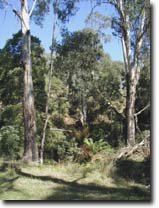Module 3: Regeneration in remnant vegetation: Overcoming the barriers
Productive Grazing, Healthy Rivers - Home
| Background The quality and long term viability of remnant riparian vegetation can be reduced or threatened by a lack of sufficient recruitment of key species, such as overstorey tree species. These trees form the basic structure of many riparian communities. In healthy riparian vegetation, recruitment of many tree species is thought to occur periodically, after flood or fire events. A number of factors could potentially limit the regeneration of key species in riparian zones. |  |
Aim This module aims to improve our knowledge of tree recruitment so that the threats posed to the regeneration of native vegetation, particularly by weeds, are identified and managed more successfully. Some of the reasons for poor recruitment of native flora in remnant riparian vegetation will be investigated, focussing on the impact of weeds on tree recruitment. This information will then be incorporated into the riparian weed management guidelines being developed in Module 4: Expert weed system. |
Our approach
Remnant riparian vegetation at a range of sites will be surveyed to assess the relationship between weed cover and the age structure of overstorey tree species, as an indicator of the success of past recruitment events. Other limiting factors include browsing by rabbits and other exotic or native animals, changes in flood regimes, and changes in soil conditions will also be assessed.
Field experiments will be established to monitor seed germination and seedling establishment in sites with different levels of weed cover and sites with the exclusion of browsers and grazers.
Related Links
The Cooperative Research Centre (CRC) for Australian Weed Management (external link) is working to enhance the sustainability of farming systems and the conservation status of natural ecosystems across Australia through world-class collaborative research that targets generic control problems using integrated weed management.
Contact
Dr Sharon Aarons
Ph: (03) 5624 2222
Email: Sharon.Aarons@dpi.vic.gov.au
Module 1: What lives along your stream? Quantifying on-farm riparian biodiversity
Productive Grazing, Healthy Rivers - Improving riparian and in-stream biodiversity - Project Report 2006 - Module 1 - Quantifying on-farm riparian biodiversity (PDF 289KB). To view the information PDF requires the use of a PDF reader. This can be installed for free from the Adobe website (external link).
Module 2: Wood to Water: habitat creation within restored and replanted riparian land
Productive Grazing, Healthy Rivers - Improving riparian and in-stream biodiversity - Project Report 2006 - Module 2 Wood to Water: Habitat creation within replanted riparian land (PDF 142KB). To view the information PDF requires the use of a PDF reader. This can be installed for free from the Adobe website (external link).
Module 3: Regeneration in remnant vegetation: overcoming the barriers
Productive Grazing, Healthy Rivers - Improving riparian and in-stream biodiversity - Project Report 2006 - Module 3 - Regeneration in remnant vegetation: Overcoming the barriers (PDF145KB). To view the information PDF requires the use of a PDF reader. This can be installed for free from the Adobe website (external link).
Module 4: Expert weed system: a support tool for on-farm management
Productive Grazing, Healthy Rivers - Improving riparian and in-stream biodiversity - Project Report 2006 - Module 4 - Riparian weed management system: Development of on-farm management tool (PDF 70KB). To view the information PDF requires the use of a PDF reader. This can be installed for free from the Adobe website (external link).
Module 5: Riparian condition and land-use practices: a survey of riparian health on dairy farms
Productive Grazing, Healthy Rivers - Improving riparian and in-stream biodiversity - Project Report 2006 - Module 5 - Riparian condition and land-use practices: A survey of riparian health & condition on dairy farms (PDF 127KB). To view the information PDF requires the use of a PDF reader. This can be installed for free from the Adobe website (external link).
Module 6: Riparian zone management: reducing water quality impacts from dairy cows
Productive Grazing, Healthy Rivers - Improving riparian and in-stream biodiversity - Project Report 2006 - Module 6 - Riparian zone management: Reducing water quality impacts on dairy cows (PDF 304KB). To view the information PDF requires the use of a PDF reader. This can be installed for free from the Adobe website (external link).


